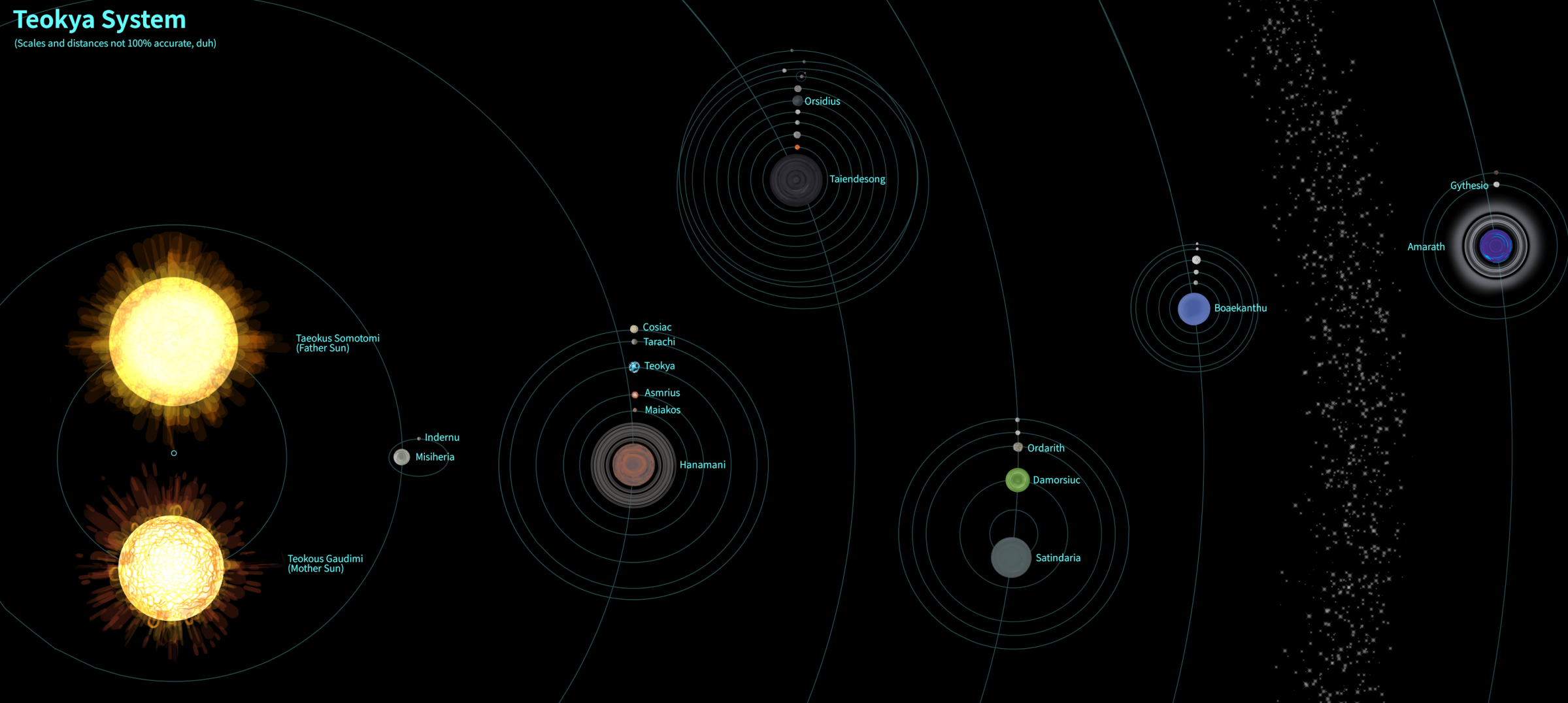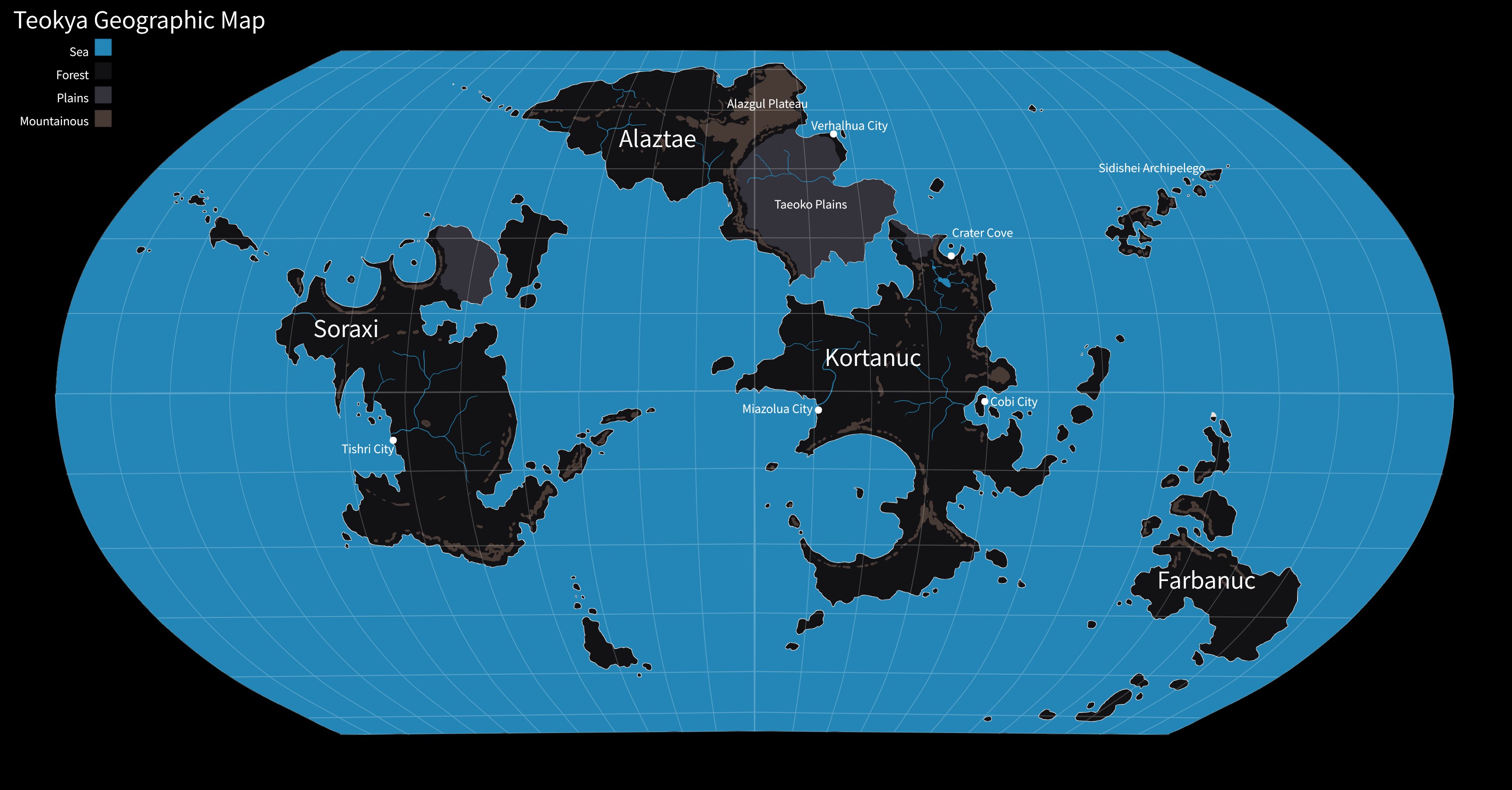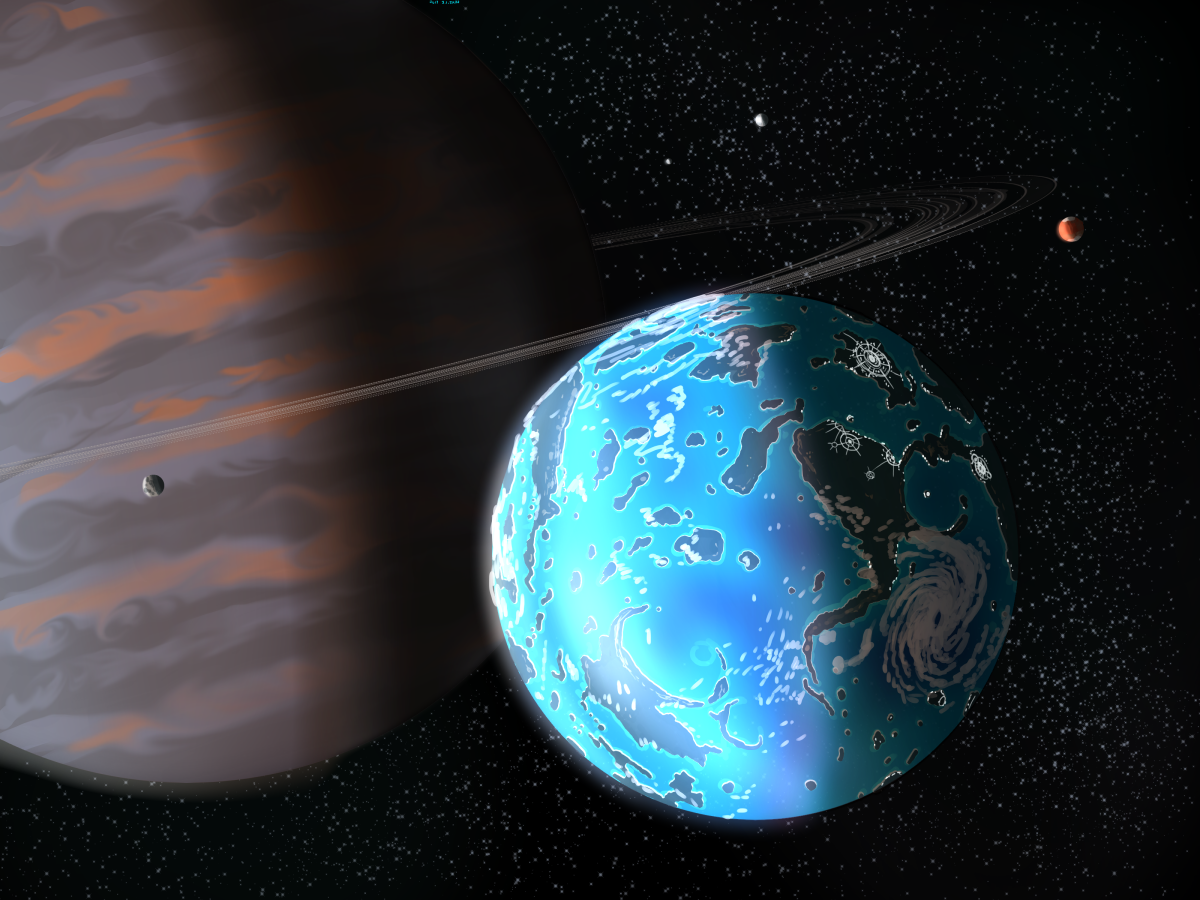Teokya is a habitable moon in the Gauss Dominion.
Cities and Population
Teokya has a population of around 9 billion which is spread out around the planet living in arcologies and small to medium sized towns. The population is predominantly native Teokyans but there are a minority of other gaussian species. The second largest demographic being Katharians who make up a population of around 500 million living in underwater cities, many of these Katharians having their own version of the Teokyan tattoos and having adopted many of their cultural customs
Cobi City
Cobi City is the capital of Teokya and the largest city on the planet. It is home to the Zaltan royal compound and surrounded by over a hundred large statues of the monarchs of the world. The city has hundreds of multi-kilometer tall archologies housing almost half a billion inhabitants, as well as significant underground and underwater construction.
Verhalhula City
Situated on the northern continent, Verhalhua city is the place of industry on Teokya. Underground mining operations work the Azangul plateau without disturbing or polluting the surface. Electronics manufacturers and atomic assembly plants dominate the city's economy. Mantle mining is used to extract Arsium and the droves of precious metals buried deep in the planet's core. The city also has ready access to the Taeoko plains thus is also known to process and export most of its agricultural products.
Tishri City
Built on the great Soraxi Swamp-Crater, Tishri city is the smallest of the major cities on the planet. It is home to Teokya University and Ecological center. The university specializes in genetic engineering of artificial life, and studying lifeforms. The University works jointly with an ecological maintenance institution responsible for monitoring the terraformed biosphere of the planet for signs of instability.
Miazolua City
The main tourist hub of Teokya, the city is known to have the best beaches, hotels, restaurants, entertainment on the planet. Though every city is ultimately partially a tourism center, Miazolua is known as a place of non stop celebration and cultural exchange.
Chungro City
Built on the largest island of the Sideshi archipelago, Chungro City is a smaller city that is known for being extravagantly wealthy. A retirement destination for the old and super rich.
Patimaki City
A floating city made up of hexagonal modules that can rearrange and move, separating and rejoining as needed. The city's economy is built on fishing the planets rich ecosystem as well as tourism, and it makes a yearly pilgrimage called the dividing, wherein each year the city breaks into sections and visits with all of the other major cities on the planet.
Crater Cove
Crater cove is a small beach town on northern Kortanuc with only a few hundred inhabitants. It is the home of Arx Montem
Infastructure
Teokya lacks a space elevator or orbital ring due to its proximity to its parent planet, a geostationary orbit would threaten such a construct with tidal forces. The threat of storms to a basic space elevator is also present. Given its relatively low gravity and population most passengers, and lack of bulk industrial imports and exports, passengers and fine goods can arrive and depart via SSTO shuttles to spaceports in the the major cities.
Hyperloop
A hypersonic vacuum train buried at a depth of three kilometers in a reinforced tunnel system, the Hyperloop runs a mostly equitorial route moving freight and passengers between the major cities. Diverging lines connect to Chungro and Verahalhula city.
Defensive infastructure
Teokya has 17 planetary defense photokinetic hard light projectors, mostly imbedded in mountain ranges and dormant volcanoes each one functioning as a moderate military stations with the capacity to sortie divisions of ground troops as well as aerospace fighters and gunships and function as emergency command centers.
Underwater missile launch systems are extensively installed. Containing standard Reaper missiles inside a flotation canister the missiles are ejected into the ocean where they float to the surface. The canister is discarded and the missile launches from the surface of the water.
Astrogeography
Teokya is the third moon of the gas giant Hanamani, the second major planet in the Teokya star system. The planet has two suns orbiting in extremely close proximity. The larger of the two, the "mother sun" being around 80% the mass of Sol, and the smaller being around 70% the mass of Sol.
Local Geography
The planet has four major continents, though hundreds of small islands.
Kortanuc is the main landmass of the planet, covered mostly in jungle with a lot of mountainous terrain and host to the most population. Mt. Tamalatata, a dormant volcano and the highest mountain on the planet at around ten kilometers in height is here. Due to the thicker atmosphere and lower gravity it is possible to visit the top of the mountain without a breathing mask.
Alaztae is a northern continent of plains and a large plateau. The Taeoko plains are the proverbial breadbasket of the planet are set below the Alazgul plateau, an area of jagged terrain thrust up several kilometers by tectonic activity. The Alazgul plateau has a number of hot springs which are frequent tourists destinations.
Soraxi is the westernmost continent, largely filled with swampland.
Farbanuc is a small continent in the southern hemisphere. Outside of a few small to medium sized settlements the continent is largely uninhabited and remote.
"Could we not have visited during the cold season?"
"It is the cold season."
Teokya has an all around tropical climate. The planet having more overall ocean, a denser atmosphere and smaller size leads to a more even distribution of heat. Though the climate in the higher latitudes is overall more temperate, Teokya has not seen snow since the later days of its terraforming. Average temperatures at the equator are 30-55 degrees celsius during the summers and 20-45 degrees during the winters.
The planet experiences two summers and two winters in each sidereal year. Teokyas seasons are not triggered by axial tilt or the distance from its stars but rather the fact that its orbit to Hanamani is inclined and does not process. This means that twice a year the orbit aligns such that the planet experiences a daily eclipse. The loss of net sunlight from this eclipse triggers a modest dip in global temperature.
The large oceans and high heat mean that intense tropical storms can develop with large storm surges. Most trees are reinforced by way of natural selection or genetic engineering and buildings are built with carbon fiber laced concrete and graphene windows to resist the 375kph winds and debris of the annual category-8 hurricanes.
The teokyan ecosystem is fairly familiar with analogues to some earth plants.
Flora
Teokyan foliage is for the most part jet black due to having several overlapping photosynthetic pigments which capture all available sunlight. This means teokyan plants which already live in a substantial greenhouse grow much faster than those on other planets.
Fern Grass
The Grass on Teokya is actually a dense carpet of small, fast-growing fern-like plants just a few inches high. These plants share a root system and nutrients and the fibers in their leaves and stems can self-repair when trampled.
Gnarlwood Trees
Gnarlwood trees grow on many worlds in many varieties. Teokyan Gnarlwoods are relatively small and have black leaves. Gnarlwood is prized for its appearance like petrified wood or marble, especially for hoytachians. Gnarlseeds are popular for making gnarlseed butter.
Galami Trees
Galami trees are genetically engineered trees. They grow a bluish-green pear shaped fruit called a Galami which are famous in the mythos of Teokya. The fruits themselves are biocompatable with a large number of alien races, containing sugars, nutrients and a high amount of citric acid. Despite having a solid flesh like an apple rather than wedges of soft flesh they technically classify as a citrus fruit. They are said to have a very tart almost sour taste. These trees are more common in orchards but wild trees exist as well.
Hydra Palms
Hydra palms resemble large palm trees growing on beaches and in low lying areas. They are so named because like a multi-headed beast the trunk does not grow straight and has the capacity to branch into multiple palm canopies. The leaves more resemble that of a fern and the trunks are reddish-brown. They distribute seeds in a pod called a (insert actual name) or in the UNE "Cucumber Coconuts". These pods are said to be edible by most biocompatible carbon-based species but have an absolutely atrocious taste of "Orange Juice, Toothpaste and Cinnamon Powder"
Marblewood Trees
Trees which grow tall and straight with spiraling patterns in their trunks. A more mundane and cheaper substitute to marblewood.
Spinwood Trees
Varieties of fast spinwood trees grow in jungles and swamps forming a dense canopy. Their trunks grow in a twisted fashion.
Hookweed
Hookweed is the colloquial name for large fern-like plants that propagate through primitive means.
Oka
A fast-growing bushy plant who's root is used to produce a stimulant beverage. There are domestic and wild varieties.
Pitcherleaf Bush
Pitcher Leaf bushes have cup shaped leaves. The leaves catch rainwater and mix it with sugars and sap produced by the plant. This concoction traps insects who go after the sugar. The insects are pulled inside the pitcherleaf and digested providing the plant nutrients.
Blackshoot
Blackshoot is a bamboo-like plant which is black, with black leaves like a fern. It is extremely fast growing and sometimes used as a building material for traditional homes.
Purmillion Fan Flower
A fan-like flower which grew in the praries. Used for making tea.
Glistening Starbloom
Only growing near the summit of Mt. Tamalatata, the glistening starbloom are beautiful flowers that can not wilt for many months after being picked. Typically given as part of a traditional teokyan marriage proposal.
Fauna
Teokya has minimal animal life.
Ebony Leafwing
A small mimicking insect, with large wings like a butterfly and a long abdomen like a dragonfly designed to look like a leaf on black foliage. They are a common food staple of animals in the teokyan ecosystem.
Septicrab
Septicrabs are a crab like creature, though they were based on a seven-fold radial body plan rather than a bilaterally symmetric one. Each appendage ended in a four-fingered claw which could retract into the ankle joint. But are otherwise crab-like in appearance. The males of the species were larger and had a vibrant red coloration with deep red stripes, with the largest varieties being around 1.2 meters in height. The males had thick ankles with spikes, such that they could retract their claws and bludgeon foes.
The Septicrabs would come ashore to mate during low tide. The males would draw a highly elaborate seven-sided symmetric mandala design into the sand which would be used to attract mates. Other males would challenge them and they would fight using their bludgeoning limbs, with some males trying to steal the display designs. Females would look for attractive or elaborate designs and mate with the males waiting in the center. Disturbing the sand mandala with a male waiting in it could lead to humans getting attacked and thus was ill-advised, because the male would view that as a territorial threat display and could incite them to attack.
Septicrabs would lay eggs underwater. They would hunt using their crushing limbs to attack and crush analogues to turtles and sessile organisms like mollusks, oysters and urchins.
There were drwarf septicrabs of several varieties and ecological niches that were smaller. Some also exhibiting the sand mandala courtship routine. Though the large variety was by far the most well known.
Septicrab meat and caviar are considered delicacies. Though the hunting or farming of wild septicrabs is frowned upon due to their high level of intelligence.
Spurat
A small mammalian creature resembling a lemur or squirrel with abnormally long multi-joined arms designed to swing from tree branches.
Cramithia
Large four winged avian animals which were genetically engineered as mounts to be used in lieu of mechanical vehicles. They are primarily piscivorous though may also eat wild fruits. Highly intelligent and docile to intelligent beings. Cramithia have two horns which are a product of their genetic engineering that can be held onto to assist in flying and steering, with the horns engineered such that different maneuvers on the horns translate into different flight maneuvers. Cramithia are made in two subspecies, shortwing and broadwing. Shortwing have shorter wings which are better suited to maneuvering in cities while broadwings were made to travel long distances and have a larger wingspan. They cannot carry the weight of more than one passenger.
Striped water Serpent
A large orange-and-black serpent-like fish which is unappealing to humans but a staple food for the Cramithia. Striped water serpents are present in freshwater swamps and lakes but not in salt water.
Pre-Space Era
Teokya was discovered and terraformed several hundred years before the formal initiation of the space conflict era by a Farrian colony ship of religious pilgrims, around 3,700 standard galactic years ago. Believers that all celestial bodies in the universe possessed a conscious energy and were sacred celestial beings. The terraformers genetically modified themselves to have silvery-white hair to reflect sunlight as when the planet stabilized after its terraforming program, it was hotter than desired but still livable. The Terraformers also engineered the Cramithia to be used as flying mounts in lieu of mechanical vehicles as well as establishing a hereditary monarchy descended from the original colony ship's captain.
Space Conflict Era
For most of the space conflict era, Teokya was inhabited by the Zaltan monarchy. Cruel and oppressive monarchs who used drug implants to control their subjects. These drug collars would inject euphoric chemicals when the working class were productive and depressants when the workers were disobedient or rebellious. This resulted in the working class citizens being addicted to serving their monarchs while still technically possessing free will. The monarchs maintained Teokya in a largely pristine state, functioning as a tourism hub for heads from the Farrian corporate coalition to take a break from exploiting the working class.
Dominion Era
Teokya has maintained moderate fame as the birthplace of one of the more recognized members of the founding nine, Merkubieth Zalta. His attainment of enlightenment saw the end of the use of drug implants.
In 1220DE, the Prime Minister approved a plan to convert the next moon in the system, Tarachi, into a major shipyard.






Comments